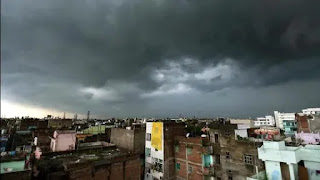While IMD is expecting good rain in the next two weeks which is likely to cover the rain deficiency, overall July rain is expected to be "below normal" over several parts of northwest India and some parts of south peninsula, central, east and northeast India
Monsoon revival, after a hiatus of ten days, has been very slow, according to India Meteorological Department. It has started raining in some parts of the country, specially in central and peninsular India but the northern limit of the monsoon (NLM) has continued to be in the same position for 22 days since June 19.
The NLM is the northernmost limit of monsoon up to which it has advanced. On Sunday, NLM continued to pass through Barmer, Bhilwara, Dholpur, Aligarh, Meerut, Ambala and Amritsar, which means the monsoon is yet to cover the entire country. It should have covered the entire country by July 8.
The sluggish revival of monsoon is due to several large-scale features, scientists said. While IMD is expecting good rain in the next two weeks which is likely to cover the rain deficiency, overall July rain is expected to be "below normal" over several parts of northwest India and some parts of south peninsula, central, east and northeast India.
As on Sunday, there is an 8% deficiency in rains with 23% deficiency over northwest India; 6% deficiency over east and northeast India and 9% deficiency over central India. There is 7% surplus over south peninsula.
Delhi has a large rain deficiency of 64%; Gujarat 47%; Haryana 37%; Punjab 41%; Kerala 39%; Odisha 20%; Manipur 62%; Arunachal Pradesh 23%, among others.
The slow revival has also led to inaccurate forecasts of monsoon onset over Delhi. IMD, for example, forecast that monsoon would advance to Delhi, Rajasthan, Punjab and Haryana on July 10. It is now likely to make onset only by the morning or afternoon of July 12. “Monsoon revival is very slow. While easterly winds did set in over Delhi, clouds did not form until Sunday. The easterly winds bring a moist air parcel but for clouds to form there has to be vertical ascent of this air which did not happen. Also, there was isolated rain in Rajasthan and Punjab but spatial distribution of rain was limited on Saturday. Now it seems like monsoon is likely to make onset on Monday over Delhi,” said RK Jenamani, senior scientist, national weather forecasting centre.
Farmers have had to deal with very unusual weather conditions in July due to the slow revival of monsoon. “Temperatures have been very high and there is no rain. This is unexpected in July. Diesel consumption has increased to run our pumps which has led to higher costs to farmers. There are power outages too. In some places, the paddy crop couldn’t sustain so it has to be sown again,” said Harinder Singh Lakhowal, general secretary, Bharatiya Kisan Union.
“There are local and global factors which influence the advance of monsoon. While the break monsoon phase was mainly due to the Madden Julian Oscillation being in an unfavourable position which has gradually resolved. The slow revival of monsoon may be due to negative Indian Ocean Dipole (IOD) in combination with neutral El Niño/Southern Oscillation conditions,” explained OP Sreejith, head, climate monitoring and prediction group, IMD Pune.
“Normally negative IOD with La Niña brings good rain. But due to the impact of negative IOD with neutral La Niña, we are expecting rains to be below normal in some parts of the country. Overall, however, rains may be normal over the country during July,” Sreejith added.
The Indian Ocean Dipole is defined by the difference in sea surface temperature between two areas– a western pole in the Arabian Sea (western Indian Ocean) and an eastern pole in the eastern Indian Ocean south of Indonesia, according to the Australian Bureau of Meteorology. IOD affects the climate of Australia and other countries that surround the Indian Ocean Basin, and is a significant contributor to rainfall variability in this region.
The next two weeks will be critical for monsoon. Lower level easterly winds from the Bay of Bengal have further extended northwestwards, reaching up to Delhi, Haryana and East Rajasthan since Sunday. Low level relative humidity has also increased over the region. Hence, the conditions continue to remain favourable for further advance of southwest monsoon over Delhi, remaining parts of West Uttar Pradesh, some more parts of Punjab, Haryana and Rajasthan during the next 24 hours. Conditions are also becoming favourable for further advance of southwest monsoon over remaining parts of the country during the subsequent 48 hours.
Under the influence of these conditions, widespread rainfall is very likely over northwest India during next 4-5 days and isolated heavy rainfall is very likely over Jammu, Kashmir, Ladakh, Gilgit-Baltistan, Muzaffarabad, Himachal Pradesh and Uttarakhand during July 11 to 13; over Punjab, Haryana and West Uttar Pradesh during July 11 to 13; over east Rajasthan during July 11 to 12.
A low pressure area has formed over westcentral and adjoining northwest Bay of Bengal off north Andhra Pradesh-south Odisha coasts and an east west shear zone is running in middle levels across Central India. Under their influence, widespread rainfall very likely over central India (Madhya Pradesh, Vidarbha, Chhattisgarh and Odisha) during next 4-5 days and isolated heavy rainfall very likely over West Madhya Pradesh, Vidarbha and Chhattisgarh on July 11.
Due to strong southwesterly winds from Arabian Sea; enhanced rainfall activity with isolated heavy to very heavy rain is very likely along the west coast and adjoining peninsular India during next 5 days.
source -HT










0 Comments